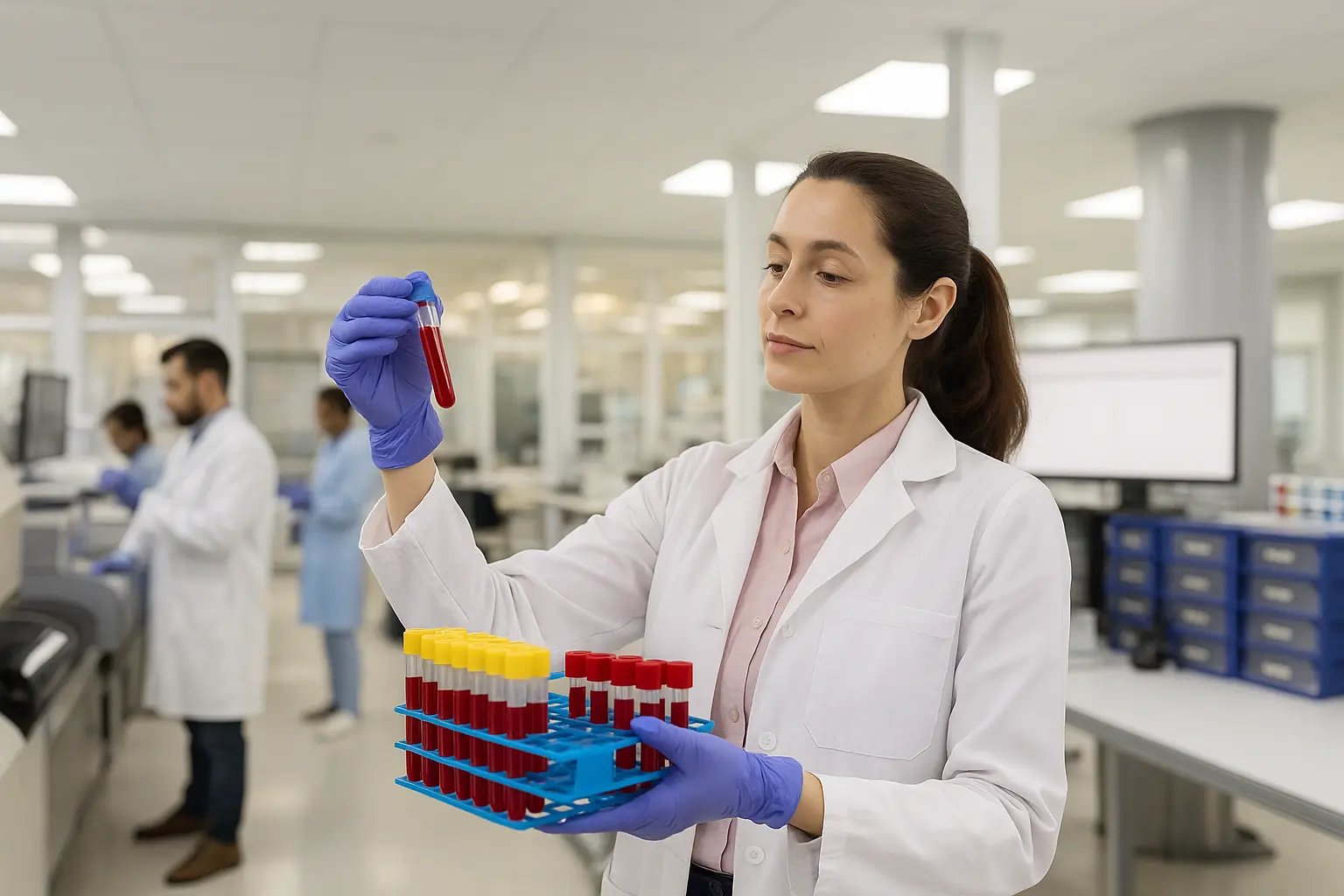Blog
Blueprint for Success: Building a Strong Financial Foundation Through Effective RCM Implementation
November 17, 2025
Successfully implementing a new laboratory revenue cycle management/lab billing system can feel like navigating a maze of moving parts: patient demographics, payer rules, coding complexity, claim scrubbing, RCM cycle workflows, and reporting dashboards, all needing to align seamlessly from day one. The stakes are high as even minor missteps can disrupt operations, delay reimbursements, and erode financial stability.
While the process may appear daunting, clinical laboratories and pathology practices that follow a proven roadmap supported by best practices, structured project management, and the right technology partner can turn complexity into opportunity, achieving greater efficiency and lasting financial stability.
This guide outlines a step-by-step blueprint for implementing laboratory billing software successfully, drawn from LigoLab’s decades of experience supporting its customers with its all-in-one laboratory information system (LIS) that features a fully integrated lab revenue cycle management (lab RCM) module. Whether you’re replacing a legacy laboratory billing solution, bringing outsourced lab billing back in-house, or optimizing an existing setup, these principles will help ensure a smooth go-live and sustainable results.
Discover More: How Much is Your Outdated Laboratory Revenue Cycle Management Costing Your Lab?
The Power of Integration: LIS System and Lab RCM Workflows Under One Roof
Before diving into the steps, it’s essential to understand why integration matters.
Most testing organizations still operate on fragmented laboratory software systems, one for laboratory information system (LIS) workflow and another for lab billing and financial operations. These disconnected environments create data silos that limit visibility, delay charge capture, and lead to revenue leakage.
Conversely, laboratories powered by LigoLab’s all-in-one platform, which seamlessly unites modern LIS system functionality with advanced lab billing automation, operate within a true system of action and a single source of truth. As a result:
- Orders, results, and charges all live within a shared pathology lab software application.
- Requisition data flows directly from accessioning to the laboratory billing process without redundant entry.
- CPT and ICD-10 coding are automatically generated and verified as part of a seamless, real-time laboratory workflow.
- Denials are reduced through automated claim scrubbing and integrated payer connectivity.
- Staff can monitor productivity, collections, and performance metrics through unified dashboards.
This synergy transforms laboratory revenue cycle management from a reactive, back-office process into a proactive, data-driven function that begins the moment an order enters the lab information system module.
Industry Insights: Why the Future of the Laboratory Information System Must Be Active, Intelligent, and Integrated
Stage 1: Project Preparation - Laying the Foundation
A successful laboratory revenue cycle management implementation starts with meticulous planning. The Project Preparation phase establishes the framework, resources, and expectations necessary to keep the project on track.
Best Practices:
- Define Clear Objectives: Determine what success looks like - improved clean claim rates, faster turnaround times, reduced A/R days, or better transparency across the RCM cycle.
- Build a Cross-Functional Team: Include leaders from operations, IT, lab billing, and compliance to ensure balanced decision-making.
- Develop a Realistic Timeline: Implementation is not a sprint - it’s a coordinated rollout. Avoid rushing milestones at the expense of data quality or training.
- Establish Communication Channels: Daily or weekly scheduled calls, as recommended in LigoLab’s project framework, foster accountability and continuous alignment.
- Assign an Internal Project Champion: This person serves as the primary liaison between your team and the RCM management company, ensuring that lab priorities remain front and center.
During this stage, laboratories also begin documenting current workflows, pain points, and data dependencies. This discovery work sets the stage for a truly tailored solution.
Industry Insights: Five Steps to More Profitable and Efficient Laboratory Billing Operations
Stage 2: Domain Analysis - Discover and Diagnose
Once foundational planning is complete, the next step is to map out the laboratory’s operational ecosystem and define how financial data moves through it. LigoLab calls this stage the Domain Analysis, or the “Discover and Diagnose” phase.
Goals:
- Gain a comprehensive understanding of the lab’s business processes and data structure.
- Identify chokepoints and redundancies in current laboratory billing workflows.
- Develop a shared understanding of how lab information system data will feed into lab RCM processes post-integration.
Key Deliverables:
- Workflow Documentation: End-to-end mapping of pre-analytical, analytical, and post-analytical steps.
- Gap Analysis: Identification of missing fields, misaligned codes, and data transfer bottlenecks.
- System Requirements: Clear definitions for what the laboratory billing system must handle (interfaces, payer rules, reporting, etc.).
- Scope and Phase Planning: Agreement on what functionality launches initially versus in future optimization cycles.
This phase is where laboratories and the LigoLab team co-author the RCM Blueprint, creating a “data framework” that governs all configurations moving forward. The more thorough this stage, the smoother the later transition to live operations.
Discover More: How Advanced and Highly Integrated Billing Automation Can Help Improve Workflow Efficiency and the Clean Claim Pass-Through Rate

Stage 3: Realization - Building the System and Training the Team
With the blueprint established, the focus shifts to execution. The Realization stage brings the plan to life, configuring the system, validating processes, and preparing users for daily operations.
Core Activities Include:
- Implementation of the Test Environment: Creating a sandbox version of the laboratory billing system for experimentation and training.
- Master File Build and Configuration: Customizing fee schedules, payer rules, client billing structures, and user roles.
- Workflow Design: Aligning automation rules, lab billing queues, and approval chains to match the lab’s business model.
- Initial Training: Adopting a “train-the-trainer” model so super-users can later guide their peers.
- System Testing and Validation: Ensuring clean data flow from the LIS system to the RCM solution, including patient demographics, coding, and charge posting.
Throughout this stage, parallel processes run concurrently, with implementation, enhancement development, and interfacing all synchronized to maintain project momentum.
Pro Tip:
Use parallel testing to enter live cases into both your legacy laboratory billing system and the new RCM platform. Compare results side-by-side to validate accuracy and identify configuration gaps before go-live.
Case Study: Summit Pathology - Achieving Laboratory Profitability Amidst Operational Pressures
Stage 4: Final Preparation - Validate and Confirm
With configurations complete, it’s time to validate every element of the new ecosystem and prepare for launch.
Focus Areas:
- End-to-End Testing: Simulate real laboratory billing scenarios, from order entry to payment posting, to ensure accuracy.
- User Acceptance Testing (UAT): Involve actual lab billing staff in testing workflows to catch usability issues early.
- Policies and SOP Documentation: Update internal documentation to reflect the new lab billing processes and responsibilities.
- End-User Training: Conduct comprehensive sessions for RCM, customer service, and management teams.
- Cutover Planning: Establish the exact timeline for switching from the test environment to live production.
LigoLab’s clean-up and clone process is a key best practice here: once testing concludes, the validated test environment is cleaned and cloned into production, guaranteeing a smooth and consistent transition.
By this stage, laboratories should have confidence that the system mirrors their business reality and that staff are well-prepared to manage new workflows.
On-Demand Webinar: Outsourced vs. In-House Laboratory Billing - How to Make the Right Choice for Your Lab
Stage 5: Go-Live - Measure, Evaluate, and Adjust
Go-live marks the moment when months of preparation culminate in real-world operation. The focus now shifts from configuration to monitoring and adaptation.
Best Practices for a Successful Launch:
- Dedicate On-Site or Virtual Support: LigoLab’s implementation model assigns dedicated staff to stay engaged throughout the go-live window, providing real-time troubleshooting and coaching.
- Maintain Daily Communication: Continue daily standups to identify emerging issues quickly and maintain alignment between teams.
- Monitor Key Metrics: Track early indicators like clean claim rate, first-pass resolution, and average reimbursement turnaround.
- Evaluate User Feedback: Encourage lab billing and operations staff to report pain points immediately, as small adjustments early can prevent major bottlenecks later.
- Adjust Workflows as Needed: Implementation isn’t over at launch; it evolves through continuous improvement.
This stage is where laboratories start to see the early financial and operational benefits of integration: fewer manual handoffs, automated claim validation, and real-time insight into revenue performance.
Discover More: Laboratory Billing Automation - Boosting Efficiency & Clean Claim Rates

Stage 6: Support - From Go-Live to Thrive
Post-launch, ongoing support becomes the key to long-term sustainability. The first two weeks after go-live are particularly critical, as end-users adapt to new processes and laboratory billing cycles begin to normalize.
LigoLab’s Support Framework Includes:
- Dedicated Live Support (First Two Weeks): Continuous assistance to resolve issues and stabilize operations.
- Transition to 24/7 Customer Support: LigoLab’s “Extreme Ownership” ethos ensures labs always have access to help when needed.
- Regular Optimization Calls: Weekly or bi-weekly reviews to analyze trends, fine-tune automation rules, and discuss enhancement opportunities.
- Performance Reporting: Using the platform’s unified dashboards to measure collection rates, payer behavior, and staff productivity.
As organizations grow and lab billing demands evolve, LigoLab’s platform scales with them, adding new automation layers, compliance updates, and payer integrations without costly upgrades or separate modules.
Discover More: Six Reasons Why You Should Choose an Integrated Laboratory Billing Solution for Your Medical Lab
Parallel Workstreams: Ensuring Efficiency Across the Project
LigoLab’s implementation strategy uniquely combines four simultaneous workstreams to maximize efficiency and reduce downtime:
- Implementation Project: Encompasses workflow design, configuration, testing, and training.
- Enhancement & Development: Covers any custom development or feature requests that align with business objectives.
- Interfacing: Ensures smooth connectivity with LIS modules, EHRs/EMRs, clearinghouses, and other third-party systems.
- Planning & Validation: Oversees timeline coordination, user acceptance, and readiness assessments.
By advancing these streams concurrently (rather than sequentially), laboratories achieve faster time-to-value and a more cohesive transition.
Discover More: Clinical Laboratory Management Solutions for Lab Revenue Cycle Management (Lab RCM)
The LigoLab Difference: Unified Data, Automated Intelligence
Implementing laboratory billing software with the latest RCM tools is more than a technical project; it’s a strategic transformation that touches every part of the laboratory. That’s why LigoLab’s all-in-one LIS & RCM informatics platform is built to support laboratories holistically, from order intake to final payment posting.
Key Advantages Include:
- Unified Data Architecture: Operational and financial data live within the same diagnostic lab software system, eliminating duplicate entry and errors.
- Automated Coding and Claim Scrubbing: Built-in CPT/ICD automation and payer-specific logic reduce denials and manual intervention.
- Real-Time Eligibility and Discovery: Integrated access to third-party verification services ensures cleaner claims before submission.
Scalable Pricing Model: Transaction-based pricing aligns costs with test volume, with no hidden fees or seat restrictions. - Comprehensive Analytics: Dashboards and reports provide actionable insights into both lab performance and financial health.
The result? Laboratories gain full control of their financial destiny, using data-driven insights to continually refine workflows, improve profitability, and support sustainable growth.
White Paper: Maximizing Your Lab’s Profitability - The Case for In-House Lab Billing
Conclusion: Plan Carefully, Validate Thoroughly, and Partner Wisely
Implementing a laboratory revenue cycle management system doesn’t have to be disruptive. With a clear blueprint, disciplined execution, and a partner committed to your success, your lab can transition smoothly, achieving both short-term wins and long-term resilience.
LigoLab’s proven implementation methodology, spanning preparation, analysis, realization, validation, go-live, and continuous support, ensures that every step of the journey is deliberate, transparent, and optimized for results. And when your lab billing system is seamlessly integrated with your LIS lab solution, you’re not just managing revenue - you’re managing your laboratory’s future.
Choose LigoLab, and empower your organization to go far beyond traditional lab billing.
Ready to learn more?






